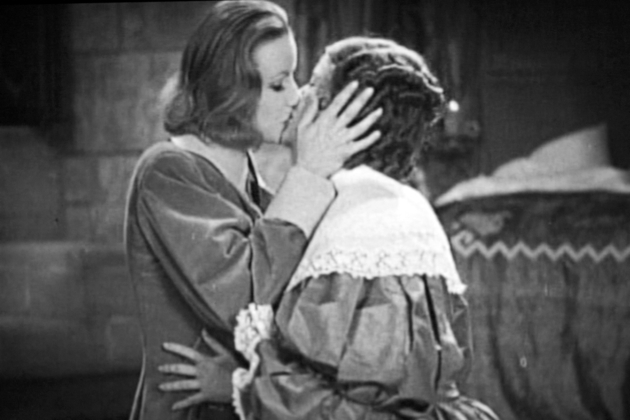
I have been friends with Caroline, the author of Garbo Laughs, since we were classmates at Mills College, a whopping 6 years ago. We started our blogs within 5 months of each other (Garbo Laughs is 5 months older!), and since then, because of our personal friendship and blogging style, Garbo Laughs and Backlots have been intertwined in many ways. Caroline is a gifted writer, and I’m certainly honored to be associated with a blog of this caliber.
For the second year in a row, Garbo Laughs is hosting its Queer Film Blogathon, a celebration of, in Caroline’s words, “lesbian, gay, bisexual, trans, or otherwise non-heterosexual, non-gender-binary depictions or personages in film.” Last year I submitted a profile of Judy Garland, because really, what would a queer blogathon be without any mention of Judy Garland? This year, I will try my luck with Queen Christina, a riveting historical account of a monarch, a fascinating study of lesbian depictions onscreen, and of what movies could get away with before the implementation of the Hays Code.

Based loosely on the life of Queen Christina of Sweden, the film takes particular care to hint subtly at the queen’s real-life sexual identity, alleged to be transgender or intersex (the queen often wore men’s clothes, had a strong, masculine voice and masculine features, never expressed an interest in marriage, and displayed a general manner that was described as being manly. The historical evidence mounted so high that in 1965 an archaeological undertaking was commissioned to explore the possibility of Queen Christina being intersex. The results were inconclusive.) It is particularly interesting that this part of the queen’s life was kept intact, while other, less controversial details of her life were fabricated or exaggerated for the movie.

Portrait of the real-life Queen Christina of Sweden.
The most famous scene in Queen Christina is one in which the queen kisses a duchess firmly on the lips in a good morning greeting. Though the textual layer of the film suggests that they’re just friends, when one reads into the subtext, in this case the facial expressions and acting technique of Greta Garbo, one is enticed to question exactly what this relationship is.
Another scene that toys with the audience’s perception and interpretation of the film is this exchange, between the Chancellor and the queen:
CHANCELLOR: But your majesty! You cannot die an old maid!
QUEEN CHRISTINA: I have no intention to, Chancellor. I shall die a bachelor!
In the days before the implementation of the revised production code in 1934, filmmakers had a much freer reign and tighter artistic control over their work, and thus many plots, scenes, and situations that we today would consider racy or controversial were frequent occurrences in the era before the Code. After the Hays Code went into effect, we began to see far less outward expression of homosexuality, as the Hays Code stipulated that “sex perversion [homosexuality] or any inference to it is forbidden.” The first known lesbian kiss onscreen occurred in 1930 in the Marlene Dietrich film Morocco:
In Queen Christina, Greta Garbo’s portrayal of the queen is striking. Her physicality in conveying the character is masterfully executed–walking with a cat-like stride, with slumped shoulders and decidedly masculine intonation in her voice, this is not the Garbo that audiences were used to. Interestingly enough, however, it seems that this was an outward expression of Garbo’s own bisexuality, which was scarcely a secret in Hollywood. She had affairs with many women over the years, notably playwright and poet Mercedes de Acosta, whose correspondence with Garbo was released in 2000. Though the Rosenbach Museum possesses love letters between them, they have not been made available to the public.
Queen Christina is a unique film with a unique place in cinema history. It is important not only as an early expression of sexuality on film, but also as a veiled hint at the sexuality of an explosive Hollywood star, and, apart from the LGBT aspect of this film, it is considered one of the best of the 1930’s and an essential classic in the Greta Garbo pantheon of films.




























_03.jpg)


I find it terribly interesting how films about strong female monarchs provided an arena for the great actresses of the 1930s to express both feminist and LGBT tendencies on the screen. I am thinking also of Bette Davis as Elizabeth and of course Katharine Hepburn in the less successful MARY OF SCOTLAND. Thank you for writing about Garbo and Dietrich, two of the great progressive female screen stars!
http://thegreatkh.blogspot.com/
Thanks for your thoughts on this movie. I have not seen it yet, but it has been sitting on my shelf waiting for my for a while and I think I am going to bump it to the front of the line now. Thanks for convincing me.
Great post, Lara! I just watched Morocco for the first time not too long ago and was struck by Deitrich’s androgynous allure. I have yet to see Queen Christina but Ill never forget the story of Garbo sacking Laurence Olivier in favour of John Gilbert, haha!
Lara, a thoughtful examination of Garbo’s sexual ambiguity in what for me is one of her two greatest performances. The other is “Camille,” in which she behaves in an unambiguously feminine manner and even uses her feminine allure professionally. What a contrast she is in “Queen Christina,” where she seems to be able to modulate her level of femininity as the situation requires. When she is in her masculine mode, she conveys this, as you note, with all her being–her manner, voice timbre, and especially her body language–that swaggering masculine gait you refer to and the way she uses her upper body, arms, and hand gestures. The way she doesn’t just give that lady-in-waiting a chaste peck but grasps her face in her hands and gives a full-bodied kiss definitely suggests something more than just platonic interest!
Goodness, the kiss is like the least gay part of that whole interaction! Thank you for this excellent contribution — I was so shocked when nobody covered Queen Christina last year, I figured I’d end up just having to do it myself, but you nailed it! And thank you so much for the very sweet words about the blog. We need to come up to the Bay soon — I miss all my Mills ladies!
Nobody did Queen Christina last year?? That really surprises me! Thanks for hosting, and you really do need to come back to the Bay for a visit. You and Molly are welcome to stay at my house, I have an extra bed!
Actually, Morocco was released a little before 1931–in November 1930. About Queen Christina, the conversation between Christina and Ebba after that kiss always reminds me of the now-canned movie & T.V. dialogues between a busy doctor (or C.E.O.) and his neglected wife (“You’re surrounded by musty old papers and musty old men, and I can’t get near you.”). Here, I find the exchange titillating precisely because–on the surface–these two are just friends.
This is a great movie and a great performance by Garbo. Did you know that the time in the seduction scene had to be meticulously followed?
For sure Queen Christina is an essential movie when it comes to queer films.
Greetings,
Le
Oops, typo! Of course Morocco was released in 1930, what was I thinking? LOL. Thanks for alerting me to that! About Queen Christina, I feel exactly the same way. The dialogue seems to be teasing us!